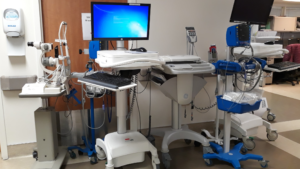
Supporting Decentralized Clinical Trials with WiFi Automation

Clinical trials play an important role in healthcare. They help advance medical knowledge and patient care, providing concrete answers to questions that would otherwise only be answered in the abstract. While the trial process can’t be entirely automated – even the best AI-models aren’t capable of fully and completely replicating a human experience – trial sponsors are continually seeking ways to use technology to improve the process. One practice that has recently become much more popular is trial decentralization.
What is trial decentralization?
Decentralized clinical trials are designed to take place at least partly in patient homes, rather than requiring participants to travel to research sites. This allows more patients to participate, which is great news for them and for researchers.
Decentralization itself is made possible by technologies such as telehealthcare, remote patient monitoring, widespread internet availability, and the growth of mobile devices. These advancements not only allow patients to interact with physicians from their homes, but also make it possible for researchers to establish mobile clinics or pop-up sites. These sites can be set-up closer to trial participants rather than requiring everyone to travel to a central research location.
Trials can be either fully decentralized, with all procedures conducted virtually and all supplies delivered to the patient; hybrid, with a mix of telehealthcare, remote data collection, and some in-person visits; or centralized, with all trial activities conducted at a research site.
This post will discuss how WiFi Automation technology can best support physicians and patients participating in decentralized and hybrid trials.
What technologies do physicians need for decentralized trials?
The overarching need is for a robust, secure, and reliable wireless network. This network is the foundation needed for most other technologies involved in the process. This includes:
- Support for remote monitoring devices worn by patients
- Support for telehealth appointments
- General communication support via emails and video calls for everyone involved in the trial
- Data storage and access of outcome assessments, patient reports, and more
- Patient portals
While patients may be in their homes or at a remote/mobile/pop-up site, physicians and researchers are far more likely to be at one location, whether that be a mobile site or a central building. That location must have the most reliable WiFi possible. Any issues such as network downtime, will result in frustrated end users, and possibly expensive trial delays. While trial sponsors and physicians can’t control the state of the WiFi in a patient’s home, they can and do depend on IT teams to ensure that the WiFi at healthcare sites is top-of-the-line with always-perfect performance.
What tools best support WiFi network optimization?
For the most reliable, problem-free networks, healthcare facilities need:
Remote Support
Depending on the location and permanence of a healthcare site, an IT team might not be consistently onsite. This requires them to have remote visibility into the network, as well as the ability to troubleshoot and resolve issues from any location at any time. This greatly reduces the Mean-time-to-Resolution, ensuring that issues are solved faster than ever.
Complete Visibility
No network can operate in absolute peak form unless IT has the ability to review, analyze, and optimize every piece of it. This requires visibility into backend and frontend infrastructure, applications, connected devices, and non-WiFi devices operating in the same airspace (an interference risk).
This visibility should be provided 24/7, and IT should always be able to review real-time and historical network data. Real-time data allows teams to solve in-the-moment issues, while historical data provides them with the ability to review network behavior when no one was on site and in the event of an intermittent issue.
Proactive, Automatic Alerts
With reactive alerts, IT is forced to respond to issues only after end users have been affected. Based on the complexity of the problem and time of the alert, this can result in resolution delays that lead to network performance degradation that lasts anywhere from minutes to days. Not ideal in any way, shape, or form.
However, with proactive, automatic alerts, IT is notified of issues as soon as they occur. This allows teams to resolve issues faster, often before end users are affected. The resolution time is made even shorter if the automatic alert contains the root cause of the issue and actionable resolutions, rather than merely a list of symptoms.
Vendor Agnostic Tools
Any tool used to provide the above capabilities should be vendor agnostic. This allows it to accurately provide data on every piece of network infrastructure, and ensures that it can be used even if network vendors change over time or across locations.
While facilities can choose to work with multiple tools, working with an all-in-one, vendor-agnostic solution simplifies optimization. Additionally, if IT only has to learn to use one technology to analyze network performance, time and money are saved on training.
The Wireless Intelligence Platform
With so much riding on a reliable WiFi network, clinical trials can’t afford any network degradation. Healthcare facilities, whether remote, mobile, pop-up, or permanent, that use the award-winning, vendor-agnostic Wireless Intelligence Platform (WIP) see:
- 90% faster Mean-Time-to-Resolutions
- 80% fewer remote site visits
- 70% fewer WiFi problem tickets
As patients, physicians, and sponsors become more comfortable with mobile health technology, and as technologies improve, we are likely to see more hybrid and decentralized clinical trials. While there are challenges involved, use WIP to ensure that network stability is never one of yours.

